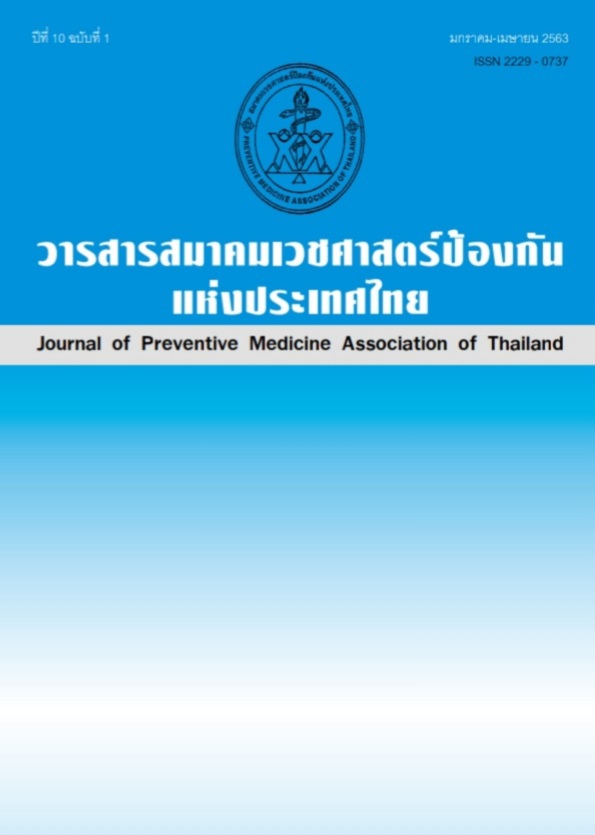The analysis of contributing factors to septic death in Pakkred Hospital
Keywords:
sepsis, community acquired sepsis, organ dysfunctionsAbstract
Sepsis is a serious condition and major cause of worldwide hospital mortality. It was also one of the major causes of deaths in Pakkred Hospital in the year 2018. This study was conducted to analyse contributing factors to septic death in Pakkred Hospital, while aiming to develop more effective care in order to reduce the overall mortality rate. The investigation was based on the evidences appeared between October 2018 and March 2019. The total number of 36 patients, consisting of 23 survivors and 13 non-survivors with community acquired sepsis was accounted for. The factors that were associated with septic death were organ dysfunctions of equal to or greater than 3 organs (survivor 17.39%, non-survivor 92.30%, P=0.000) especially in respiratory system (survivor 30.43%, non-survivor 76.92%, P=0.007) peripheral tissue/metabolic acidosis (survivor 8.69%, non-survivor 69.23%, P=0.000) and hepatic system (survivor 4.34%, non-survivor 30.76%, P=0.028). Intravenous fluid therapy was considered adequate and appropriate in both groups. On the contrary, the delay in the administration of intravenous antibiotics was found in both groups. This information is key imperative to the planning and development of the care for sepsis patients in Pakkred hospital in the future.
References
2. Gotts JE, Matthay MA. Sepsis: pathophysiology and clinical management. BMJ 2016;353:i1585.
3. ชูวงศ์ มหรรทัศนพงศ์. ผลลัพธ์ของ Surin sepsis treatment protocol ในการจัดการดูแลรักษาภาวะติดเชื้อในกระแสเลือด. ศรีนครินทร์เวชสาร 2555;27:332-9
4. Fleischmann C, Scherag A, Adhikari NK, Hartog CS, Tsaganos T, Schlattmann P, et al. Assessment of Global Incidence and Mortality of Hospital-treated Sepsis. Current Estimates and Limitations. Am J Respir Crit Care Med 2016;193:259-72.
5. Chuesakoolvanich K. Septic Death in Adults at Surin Hospital: An Investigation of Real-Life Clinical Practice vs. Empirical Guidelines. J Med Assoc Thai 2007;90:2039-46.
6. Rannikko J, Syrjanen J, Seiskari T, Aittoniemi J, Huttunen R. Sepsis-related mortality in 497 cases with blood culture-positive sepsis in an emergency department. Int J Infect Dis 2017;58:52-57.
7. Capan M, Hoover S, Ivy JS, Miller KE, Arnold R. Not all organ dysfunctions are created equal-Prevalence and mortality in sepsis. J Crit Care 2018;48:257-62. DOI: 10.1016/j.jcrc.2018.08.021
8. Rhee C, Jones TM, Hamad Y, Pande A, Varon J, O’Brien C, et al .Prevalence, underlying causes, and preventability of Sepsis-Associated Mortality in US Acute Care Hospitals. JAMA Network Open 2019;2:e187571. doi:10.1001/jamanetworkopen.2018.7571.
9. Khuri CE, Dagher GA, Chami A, Chebl RB, Amoun T, Bachir R, et al .The impact of EGDT on sepsis mortality in a single tertiary care center in Lebanon. Emergency Medicine International [Internet]. 2019 [cited 2019 Jan 15]. Available from:https://www.hindawi.com/journals/emi/2019/8747282
10. นงลักษณ์ โคว้ตระกูล. ผลการพัฒนาคุณภาพระบบการจัดการผู้ป่วยรายกรณีติดเชื้อในกระแสเลือดของโรงพยาบาลสมเด็จพระยุพราชสระแก้ว. วารสารพยาบาลโรคหัวใจและทรวงอก 2557;2:122-34.
11. ยุวดี เทียมสุวรรณ. การพัฒนาระบบการดูแลผู้ป่วยหนักที่ติดเชื้อในกระแสเลือด โดยการจัดการรายกรณีโรงพยาบาลสรรพสิทธิประสงค์ อุบลราชธานี. วารสารการพยาบาลและการดูแลสุขภาพ 2550;35:184-93.
12. กรรณิกา อำพนธ์. ผลลัพธ์ของการพัฒนาการดูแลผู้ป่วยติดเชื้อในกระแสเลือด โรงพยาบาลพระปกเกล้า. วารสารศูนย์การศึกษาแพทยศาสตร์คลินิก โรงพยาบาลพระปกเกล้า 2560;3,222-36.
13. วิไลวรรณ เนื่อง ณ สุวรรณ. การพัฒนาแนวปฏิบัติการพยาบาลผู้ป่วยที่มีภาวะติดเชื้อในกระแสเลือดอย่างรุนแรง. วารสารการพยาบาลและการดูแลสุขภาพ 2557;32:25-36.
Downloads
Published
How to Cite
Issue
Section
License
บทความที่ลงพิมพ์ในวารสารเวชศาสตร์ป้องกันแห่งประเทศไทย ถือเป็นผลงานวิชาการ งานวิจัย วิเคราะห์ วิจารณ์ เป็นความเห็นส่วนตัวของผู้นิพนธ์ กองบรรณาธิการไม่จำเป็นต้องเห็นด้วยเสมอไปและผู้นิพนธ์จะต้องรับผิดชอบต่อบทความของตนเอง






